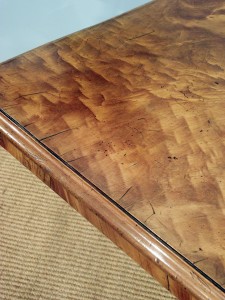 Here at Thakeham Furniture we have workshops specialising in the conservation of antique furniture. Our head restorer, Anthony Tester, has over 40 years experience in the field, and is a master of the myriad skills needed … cabinet work, marquetry, French and wax polishing, repairing locks, woodcarving, veneer work, silver soldering brassware – the list is endless!
Here at Thakeham Furniture we have workshops specialising in the conservation of antique furniture. Our head restorer, Anthony Tester, has over 40 years experience in the field, and is a master of the myriad skills needed … cabinet work, marquetry, French and wax polishing, repairing locks, woodcarving, veneer work, silver soldering brassware – the list is endless!
One of the most common repairs is re-laying a bubble or ‘blister’ in a veneered top. Veneers were laid using ‘Scotch’ glue, made from the hides and hooves of animals. We still use it today, as it is one of the best and strongest glues … and has the added advantage of being water soluble, so can be easily washed off, unlike modern glues. Araldite and its like cause untold grief to restorers, and should never be used!
Over time Scotch glue can dry out and crystallise, leading to veneers lifting. Our first approach is to try to lay the veneer by applying some heat, which can melt the glue beneath and reactivate it. This is achieved by working across the surface with a heated veneer “hammer”. If the bubble is too big for this, it will have to be sliced very delicately with the grain, using a scalpel. After this hot glue is injected under the veneer, which is then held down under pressure with a clamp until the glue dries – if cleverly done, an almost imperceptible ‘repair’.